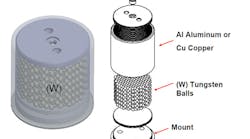NASA has granted an exclusive worldwide license to electronic components and packaging manufacturer TopLine for a particle damping technology, which is intended to ease the effects of vibration on printed circuit boards (PCBs). The NASA invention is described in U.S. Patent Application Serial No. 14/196,203 entitled “Vibration Dimpling Device for Circuit Card Assemblies,” and refers to a particle impact damper (PID) designed to absorb vibrations that would otherwise impact circuit card assemblies.
Developed at NASA Marshall Space Flight Center, the invention provides a solution for PCBs and their components that must operate in environments characterized by harsh vibration, such onboard aircraft. The PID is mounted near the geometric center of a PCB (see figure) where the forces from vibration are the greatest. Kinetic energy from the vibrations is transferred to the PID and its center-mounted tungsten balls, which provide a significant reduction in the effects of vibration for the PCB.
The PIDs are manufactured with commercial-off-the-shelf (COTS) components and can be applied to applications in commercial, industrial, and military areas. The PIDs can be mounted to a PCB by numerous mounting methods, including snap-in mounting, surface-mount soldering, epoxy mounting, and screw mounting.


